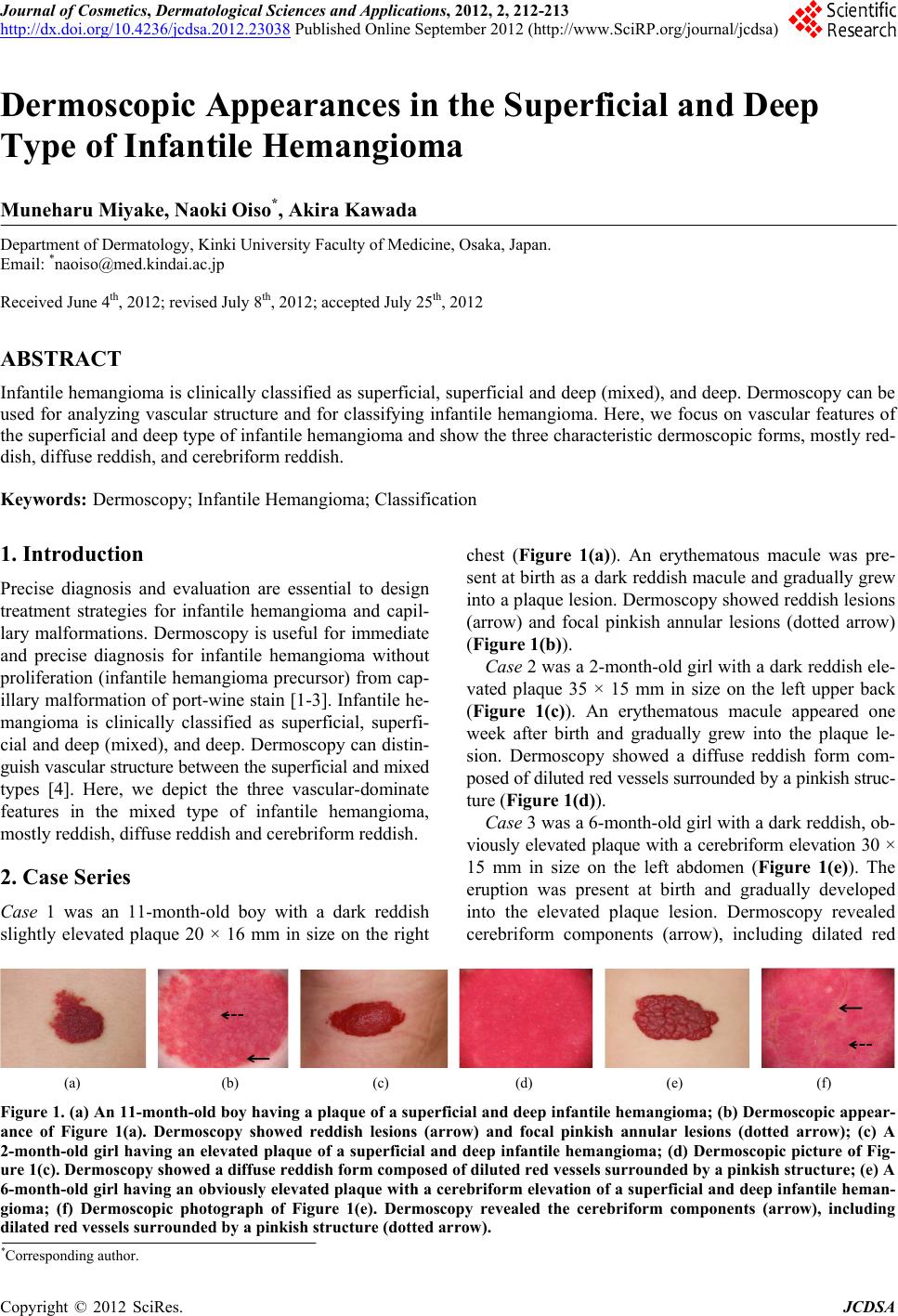
Journal of Cosmetics, Dermatological Sciences and Applications, 2012, 2, 212-213
http://dx.doi.org/10.4236/jcdsa.2012.23038 Published Online September 2012 (http://www.SciRP.org/journal/jcdsa)
Dermoscopic Appearances in the Superficial and Deep
Type of Infantile Hemangioma
Muneharu Miyake, Naoki Oiso*, Akira Kawada
Department of Dermatology, Kinki University Faculty of Medicine, Osaka, Japan.
Email: *naoiso@med.kindai.ac.jp
Received June 4th, 2012; revised July 8th, 2012; accepted July 25th, 2012
ABSTRACT
Infantile hemangioma is clinically classified as superficial, superficial and deep (mixed), and deep. Dermoscopy can be
used for analyzing vascular structure and for classifying infantile hemangioma. Here, we focus on vascular features of
the superficial and deep type of infantile hemangioma and show the three characteristic dermoscopic forms, mostly red-
dish, diffuse reddish, and cerebriform reddish.
Keywords: Dermoscopy; Infantile Hemangioma; Classification
1. Introduction
Precise diagnosis and evaluation are essential to design
treatment strategies for infantile hemangioma and capil-
lary malformations. Dermoscopy is useful for immediate
and precise diagnosis for infantile hemangioma without
proliferation (infantile hemangioma precursor) from cap-
illary malformation of port-wine stain [1-3]. Infantile he-
mangioma is clinically classified as superficial, superfi-
cial and deep (mixed), and deep. Dermoscopy can distin-
guish vascular structure between the superficial and mixed
types [4]. Here, we depict the three vascular-dominate
features in the mixed type of infantile hemangioma,
mostly reddish, diffuse reddish and cerebriform reddish.
2. Case Series
Case 1 was an 11-month-old boy with a dark reddish
slightly elevated plaque 20 × 16 mm in size on the right
chest (Figure 1(a)). An erythematous macule was pre-
sent at birth as a dark reddish macule and gradually grew
into a plaque lesion. Dermoscopy showed reddish lesions
(arrow) and focal pinkish annular lesions (dotted arrow)
(Figure 1(b)).
Case 2 was a 2-month-old girl with a dark reddish ele-
vated plaque 35 × 15 mm in size on the left upper back
(Figure 1(c)). An erythematous macule appeared one
week after birth and gradually grew into the plaque le-
sion. Dermoscopy showed a diffuse reddish form com-
posed of diluted red vessels surrounded by a pinkish struc-
ture (Figure 1(d)).
Case 3 was a 6-month-old girl with a dark reddish, ob-
viously elevated plaque with a cerebriform elevation 30 ×
15 mm in size on the left abdomen (Figure 1(e)). The
eruption was present at birth and gradually developed
into the elevated plaque lesion. Dermoscopy revealed
cerebriform components (arrow), including dilated red
(a) (b) (c) (d) (e) (f)
Figure 1. (a) An 11-month-old boy having a plaque of a superficial and deep infantile hemangioma; (b) Dermoscopic appear-
ance of Figure 1(a). Dermoscopy showed reddish lesions (arrow) and focal pinkish annular lesions (dotted arrow); (c) A
2-month-old girl having an elevated plaque of a superficial and deep infantile hemangioma; (d) Dermoscopic picture of Fig-
ure 1(c). Dermoscopy showed a diffuse reddish form composed of diluted red vessels surrounded by a pinkish structure; (e) A
6-month-old girl having an obviously elevated plaque with a cerebriform elevation of a superficial and deep infantile heman-
gioma; (f) Dermoscopic photograph of Figure 1(e). Dermoscopy revealed the cerebriform components (arrow), including
ilated red vessels surrounded by a pinkish structure (dotted arrow). d
*Corresponding author.
Copyright © 2012 SciRes. JCDSA